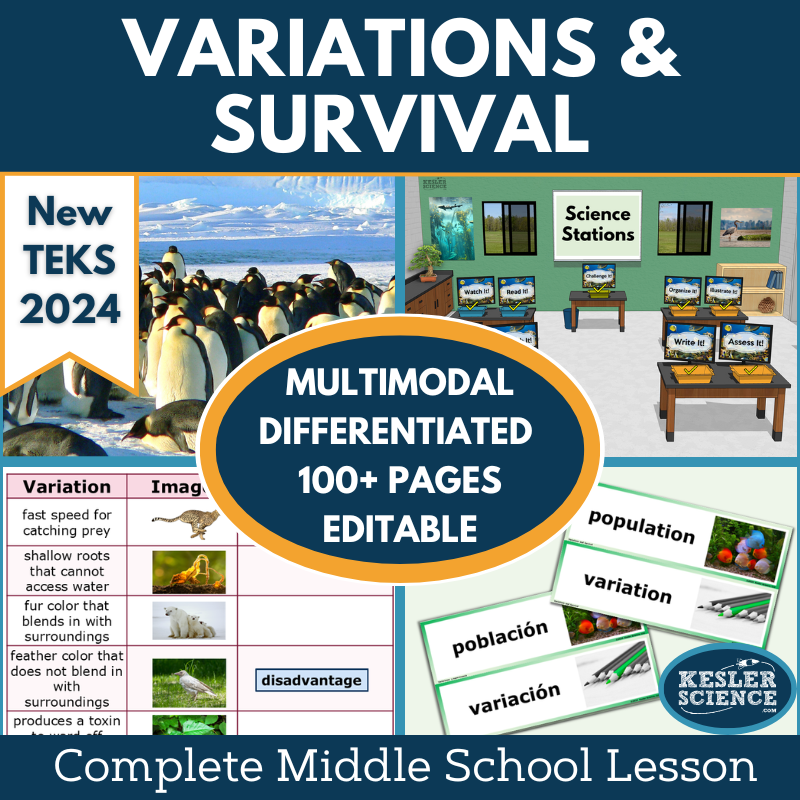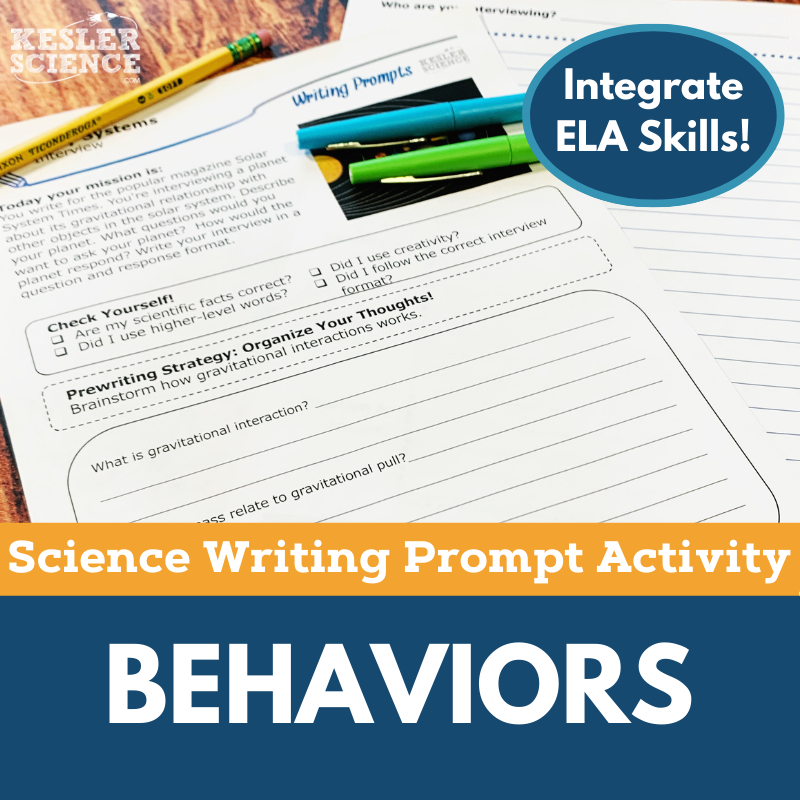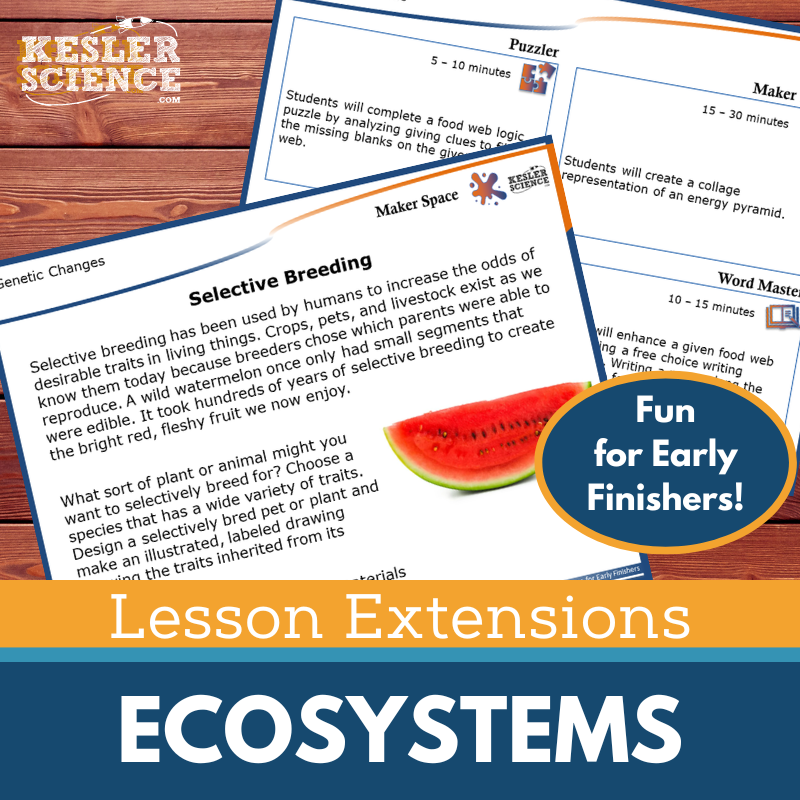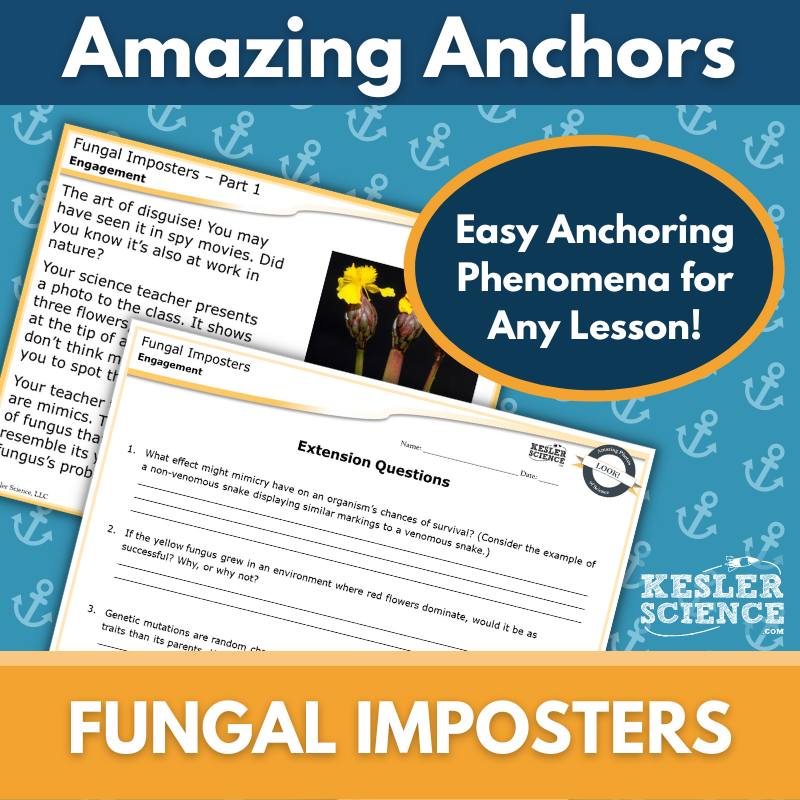Variations & Survival Activities for Middle School Science
This engaging 5E lesson helps middle school students explore how variations within a population can be advantageous or disadvantageous as environments change, aligning with TEKS 6.13C. The resources below will give students a comprehensive understanding of variations and survival. All of the following materials are also included in the Kesler Science Membership.
The Kesler Science Ecosystems 5E Lesson is a comprehensive, low-prep unit designed to help middle school students explore how variations within a population can be advantages or disadvantages as environments change. Aligned with the 2021 TEKS 6.13C standard, the lesson includes editable presentations, worksheets, choice projects, assessments, and materials in both English and Spanish.
Following the 5E Model, the unit begins with engaging activities and vocabulary support. Students then explore concepts through a differentiated, student-led station lab featuring hands-on experiments, reading passages, research tasks, videos, and creative output activities like drawing and writing. An optional challenge station extends learning for advanced students. Explanation materials include editable PowerPoints, interactive notebooks, and note-taking templates. Students apply their understanding through choice projects and demonstrate mastery with STAAR 2.0-aligned assessments, review questions, and worksheets. Designed for flexibility, this lesson works seamlessly for both in-class and virtual learning environments.
The Kesler Science Ecosystems 5E Lesson is a comprehensive, low-prep unit designed to help middle school students explore how variations within a population can be advantages or disadvantages as environments change. Aligned with the 2021 TEKS 6.13C standard, the lesson includes editable presentations, worksheets, choice projects, assessments, and materials in both English and Spanish.
Following the 5E Model, the unit begins with engaging activities and vocabulary support. Students then explore concepts through a differentiated, student-led station lab featuring hands-on experiments, reading passages, research tasks, videos, and creative output activities like drawing and writing. An optional challenge station extends learning for advanced students. Explanation materials include editable PowerPoints, interactive notebooks, and note-taking templates. Students apply their understanding through choice projects and demonstrate mastery with STAAR 2.0-aligned assessments, review questions, and worksheets. Designed for flexibility, this lesson works seamlessly for both in-class and virtual learning environments.
This student-led station lab, aligned with the 2021 TEKS standard 6.13C, engages middle school students in exploring how variations within a population can influence survival as environments change. Designed for both in-class and virtual learning, the lesson encourages students to take charge of their own learning while teachers guide the process. With nine differentiated stations, students interact with concepts through reading, research, videos, and hands-on activities, promoting active engagement and critical thinking.
The stations are divided into INPUT and OUTPUT activities. INPUT stations introduce new concepts through interactive tasks, videos, reading passages (available in English and Spanish), and research activities using facts, images, and graphs. OUTPUT stations allow students to demonstrate their understanding by organizing information, illustrating models, writing responses, and completing assessments. A bonus Challenge It! station offers extension tasks like crosswords, games, and mini-projects for early finishers and advanced learners. This versatile resource is low-prep and adaptable, making it ideal for any learning environment.
This student-led station lab, aligned with the 2021 TEKS standard 6.13C, engages middle school students in exploring how variations within a population can influence survival as environments change. Designed for both in-class and virtual learning, the lesson encourages students to take charge of their own learning while teachers guide the process. With nine differentiated stations, students interact with concepts through reading, research, videos, and hands-on activities, promoting active engagement and critical thinking.
The stations are divided into INPUT and OUTPUT activities. INPUT stations introduce new concepts through interactive tasks, videos, reading passages (available in English and Spanish), and research activities using facts, images, and graphs. OUTPUT stations allow students to demonstrate their understanding by organizing information, illustrating models, writing responses, and completing assessments. A bonus Challenge It! station offers extension tasks like crosswords, games, and mini-projects for early finishers and advanced learners. This versatile resource is low-prep and adaptable, making it ideal for any learning environment.
The Variations & Survival Student Choice Projects align with the 2021 TEKS standard 6.13C, allowing middle school students to choose a project that matches their preferred output style. A project page offers six student-led options plus a “design your own” project, accompanied by an editable rubric for teacher, peer, or self-assessment. This resource is also part of the Variations & Survival Complete Lesson for TEKS 6.13C.
These flexible projects support creative expression through multimodal choices and can be adapted to meet various grading needs. Two versions of the project page offer differentiation: a modified version supports students needing remediation, while advanced learners can be challenged with multiple project assignments using the same rubric.
The resource includes nine project options, teacher directions for support and suggestions, and editable rubric pages assessing vocabulary, concepts, presentation, clarity, and accuracy. Projects are designed for completion with standard classroom supplies like paper, markers, and scissors, though many can also be done digitally.
The Variations & Survival Student Choice Projects align with the 2021 TEKS standard 6.13C, allowing middle school students to choose a project that matches their preferred output style. A project page offers six student-led options plus a “design your own” project, accompanied by an editable rubric for teacher, peer, or self-assessment. This resource is also part of the Variations & Survival Complete Lesson for TEKS 6.13C.
These flexible projects support creative expression through multimodal choices and can be adapted to meet various grading needs. Two versions of the project page offer differentiation: a modified version supports students needing remediation, while advanced learners can be challenged with multiple project assignments using the same rubric.
The resource includes nine project options, teacher directions for support and suggestions, and editable rubric pages assessing vocabulary, concepts, presentation, clarity, and accuracy. Projects are designed for completion with standard classroom supplies like paper, markers, and scissors, though many can also be done digitally.
The Natural Selection Inquiry Lab aligns with TEKS and NGSS, helping students explore how environmental and genetic factors influence populations over time. Through a hands-on simulation with a population of bunnies that display fur variation, students investigate how desirable and undesirable traits change across generations, the impact of environmental pressures, and the effects of both natural and artificial selection.
This resource includes three differentiated labs designed to support all learners: a structured version for those needing more guidance, a moderately guided version for on-level students, and an independent version for advanced learners. Reflection questions encourage students to practice making claims supported by evidence and reasoning.
The lab requires simple materials like dry beans, colored pencils, a breeding placemat, and plastic cups. Editable teacher resources, answer keys, and clear instructions are included to simplify planning and grading, providing an engaging and accessible learning experience.
The Natural Selection Inquiry Lab aligns with TEKS and NGSS, helping students explore how environmental and genetic factors influence populations over time. Through a hands-on simulation with a population of bunnies that display fur variation, students investigate how desirable and undesirable traits change across generations, the impact of environmental pressures, and the effects of both natural and artificial selection.
This resource includes three differentiated labs designed to support all learners: a structured version for those needing more guidance, a moderately guided version for on-level students, and an independent version for advanced learners. Reflection questions encourage students to practice making claims supported by evidence and reasoning.
The lab requires simple materials like dry beans, colored pencils, a breeding placemat, and plastic cups. Editable teacher resources, answer keys, and clear instructions are included to simplify planning and grading, providing an engaging and accessible learning experience.
This science reading comprehension lesson introduces students to the concept of variation within populations and how these differences can enhance survival. Through a nonfiction article, students explore examples of adaptations in various species, followed by comprehension questions that reinforce key ideas. As an extension, students research an organism of their choice and categorize its adaptations, promoting critical thinking and deeper understanding of survival strategies in nature.
Designed for middle school students in grades 6–8 (and advanced 5th graders), this resource supports both science literacy and reading comprehension with leveled passages ranging from 1100–1300 Lexile. The lesson includes five to seven comprehension questions, a hands-on mini-project, and a Cornell notes template to help students organize their learning. Engaging visuals, which print clearly in grayscale, add an extra layer of interest to the activity.
This versatile resource is ideal for virtual or in-person learning and is compatible with platforms like Google Classroom, MS Teams, Schoology, and Canvas. Whether used for sub plans, extra credit, ISS, or whole-class instruction, this lesson encourages classroom discussions, builds critical thinking skills, and strengthens students’ ability to analyze scientific texts.
This science reading comprehension lesson introduces students to the concept of variation within populations and how these differences can enhance survival. Through a nonfiction article, students explore examples of adaptations in various species, followed by comprehension questions that reinforce key ideas. As an extension, students research an organism of their choice and categorize its adaptations, promoting critical thinking and deeper understanding of survival strategies in nature.
Designed for middle school students in grades 6–8 (and advanced 5th graders), this resource supports both science literacy and reading comprehension with leveled passages ranging from 1100–1300 Lexile. The lesson includes five to seven comprehension questions, a hands-on mini-project, and a Cornell notes template to help students organize their learning. Engaging visuals, which print clearly in grayscale, add an extra layer of interest to the activity.
This versatile resource is ideal for virtual or in-person learning and is compatible with platforms like Google Classroom, MS Teams, Schoology, and Canvas. Whether used for sub plans, extra credit, ISS, or whole-class instruction, this lesson encourages classroom discussions, builds critical thinking skills, and strengthens students’ ability to analyze scientific texts.
The Behaviors Science Writing Prompt Activity engages middle school students in a persuasive essay exercise that reinforces life science concepts, focusing on behaviors that enhance survival. Aligned with TEKS, this activity encourages students to explain variation within a population or species by comparing external features, behaviors, or physiology—such as migration, hibernation, or food storage.
This low-prep, student-centered resource supports both in-person and virtual learning, offering materials in digital and print formats. It includes teacher directions with answer guides, project ideas, and rubrics; a projection version for classroom display; full-sized and half-sheet handouts for writing prompts, self-checks, and templates; and an interactive PowerPoint version compatible with Google Slides.
Ideal for cross-curricular projects, pre-test assessments, student choice assignments, early finisher elaboration, extra credit, make-up work, TELPAS samples, or differentiation exercises, this versatile activity fosters creativity and scientific reasoning. It also works well for classroom displays or student anthologies. Designed for review, it assumes students have prior knowledge of the topic or access to research materials.
The Behaviors Science Writing Prompt Activity engages middle school students in a persuasive essay exercise that reinforces life science concepts, focusing on behaviors that enhance survival. Aligned with TEKS, this activity encourages students to explain variation within a population or species by comparing external features, behaviors, or physiology—such as migration, hibernation, or food storage.
This low-prep, student-centered resource supports both in-person and virtual learning, offering materials in digital and print formats. It includes teacher directions with answer guides, project ideas, and rubrics; a projection version for classroom display; full-sized and half-sheet handouts for writing prompts, self-checks, and templates; and an interactive PowerPoint version compatible with Google Slides.
Ideal for cross-curricular projects, pre-test assessments, student choice assignments, early finisher elaboration, extra credit, make-up work, TELPAS samples, or differentiation exercises, this versatile activity fosters creativity and scientific reasoning. It also works well for classroom displays or student anthologies. Designed for review, it assumes students have prior knowledge of the topic or access to research materials.
The WIKI Tickets© Ecosystems Set offers engaging formative assessments designed for 6th-8th grade science, providing flexible options to gauge student understanding. This set includes 20 assessments, each available in five formats: a full-screen projection version, three printable handout sizes (full, split, and quarter-page), and a digital interactive version compatible with PowerPoint and Google Slides. Aligned with NGSS and TEKS standards, every standard is covered with at least one ticket, and a table of contents is included to highlight the alignment.
These assessments cover key ecosystem topics such as biodiversity, biotic and abiotic factors, taxonomy, competition for resources, ecological succession, food chains and webs, human impact on oceans, microhabitats, photosynthesis, and environmental impacts. Designed for versatility, WIKI Tickets© can be used as exit tickets, bellringers, or quick checks for understanding. Whether projected for class discussion, printed for individual work, or assigned digitally for remote learning, these colorful and engaging assessments help teachers track student progress effectively in any learning environment.
The WIKI Tickets© Ecosystems Set offers engaging formative assessments designed for 6th-8th grade science, providing flexible options to gauge student understanding. This set includes 20 assessments, each available in five formats: a full-screen projection version, three printable handout sizes (full, split, and quarter-page), and a digital interactive version compatible with PowerPoint and Google Slides. Aligned with NGSS and TEKS standards, every standard is covered with at least one ticket, and a table of contents is included to highlight the alignment.
These assessments cover key ecosystem topics such as biodiversity, biotic and abiotic factors, taxonomy, competition for resources, ecological succession, food chains and webs, human impact on oceans, microhabitats, photosynthesis, and environmental impacts. Designed for versatility, WIKI Tickets© can be used as exit tickets, bellringers, or quick checks for understanding. Whether projected for class discussion, printed for individual work, or assigned digitally for remote learning, these colorful and engaging assessments help teachers track student progress effectively in any learning environment.
Lesson Extensions offer engaging, student-choice activities designed to challenge early finishers with creative and critical thinking tasks. Ideal for wrapping up lessons, filling downtime during testing, or keeping students focused, these activities provide rigorous yet enjoyable learning opportunities connected to NGSS and TEKS standards focused on ecosystems.
Each extension features four interactive components: Puzzler for problem-solving, Maker Space for hands-on STEAM activities, Tech Connection for digital demonstrations, and Word Master for creative writing. Resources include teacher directions, answer keys, and both projection and printable formats for classroom flexibility.
These high-level, independent learning tools help students dive deeper into topics such as biodiversity, biomes, ecosystem interactions, food webs, human impact, photosynthesis, natural hazards, and survival strategies. They are perfect for enriching early finishers and reinforcing key ecosystem concepts.
Lesson Extensions offer engaging, student-choice activities designed to challenge early finishers with creative and critical thinking tasks. Ideal for wrapping up lessons, filling downtime during testing, or keeping students focused, these activities provide rigorous yet enjoyable learning opportunities connected to NGSS and TEKS standards focused on ecosystems.
Each extension features four interactive components: Puzzler for problem-solving, Maker Space for hands-on STEAM activities, Tech Connection for digital demonstrations, and Word Master for creative writing. Resources include teacher directions, answer keys, and both projection and printable formats for classroom flexibility.
These high-level, independent learning tools help students dive deeper into topics such as biodiversity, biomes, ecosystem interactions, food webs, human impact, photosynthesis, natural hazards, and survival strategies. They are perfect for enriching early finishers and reinforcing key ecosystem concepts.
This Amazing Anchors Phenomenon Lesson introduces population variation through an engaging real-world example involving a fungus in disguise. It begins with an introductory reading accompanied by comprehension and extension questions to prepare students for deeper learning. A follow-up explanatory reading breaks down the science behind population variation, reinforced with additional questions to extend understanding.
This no-prep resource includes teacher directions, answer keys, projection slides, and both print and digital formats suitable for Google Classroom or other LMS platforms. A differentiated version offers language supports and sentence starters to assist students. Designed to complement your own lesson content, these readings effectively frame and reinforce any science lesson.
This Amazing Anchors Phenomenon Lesson introduces population variation through an engaging real-world example involving a fungus in disguise. It begins with an introductory reading accompanied by comprehension and extension questions to prepare students for deeper learning. A follow-up explanatory reading breaks down the science behind population variation, reinforced with additional questions to extend understanding.
This no-prep resource includes teacher directions, answer keys, projection slides, and both print and digital formats suitable for Google Classroom or other LMS platforms. A differentiated version offers language supports and sentence starters to assist students. Designed to complement your own lesson content, these readings effectively frame and reinforce any science lesson.
Year-Round Resources
These year-round activities will increase your students' understanding of many middle school science topics. All of these activities are also included in the Kesler Science Membership.
Visual Data & Graphing
You're not alone if your students struggle with understanding graphs, charts, and tables. It's a skill that takes an enormous amount of practice. This resource will help students build a strong foundation in analyzing data and creating their own data visualizations.
Bell Ringers and Warm-Ups
These middle school science bell ringers are an excellent way to engage your students as soon as they walk into your classroom. This comprehensive FULL YEAR resource includes everything you need to start off each science class with an interesting warm-up activity.
Review Board Games
Each game board has been carefully designed to keep students engaged. There are 10 different action spaces on each board and dozens of question cards. All of the actions are related to science concepts and keep the students motivated throughout the game.
Each game is ready to play. Simply print out the board and the cards and let the students enjoy reviewing nine different units.
Essential Questions and Standards
Below are the essential questions and standards associated with the lessons and activities included in the atoms unit. This topic is only one of more than 100 middle school science topics included in the Kesler Science Membership.
-
What are examples of variations in a population?
-
How can variations in a population be an advantage as environments change?
-
How can variations in a population be a disadvantage as environments change?
-
TEKS Science - 6.13C Variations & Survival
Kesler Science Membership
Imagine never having to search for another middle school science lesson again. The membership gives you access to ALL of the Kesler Science products in one place (Yes, including everything above).
Say goodbye to long hours of lesson prep.



















